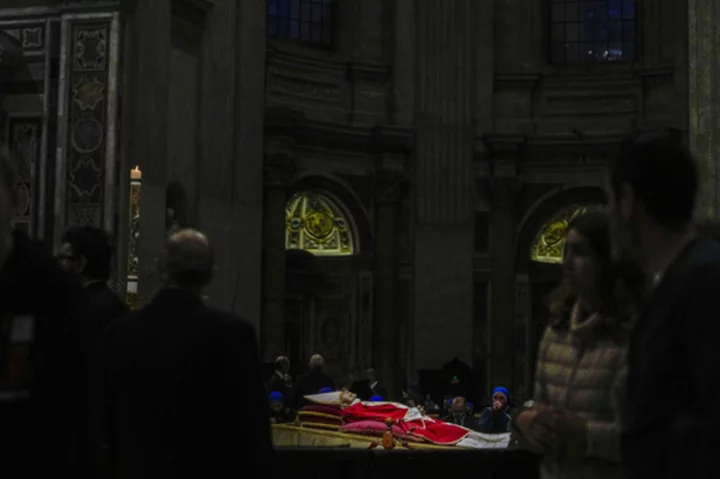Two moments, at opposite ends of the human experience.
In the first, on July 20, a woman squats in the thick mud in Raigad, India, as she peers out from a plastic tarp that covers her body. Her face is frozen in anguish and uncertainty as she faces the most dire of circumstances — the realization that her family is trapped under rubble after a landslide.
The second scene could not be more different. It is from March 2, on the beach in Gaza City — a starkly different Gaza City than the one its residents are experiencing today. In this image, a group of Palestinians sit in chairs under an umbrella enjoying a day at the beach. In the background, a man rides by on a horse; both are airborne, their image reflected in water on the sand.
Unthinkable anguish. Casual joy. And everything in between, too — in a world where, it is proven over and over, anything can happen and often does.
The mission of photojournalism is to capture moments that represent — and, at their best, truly reveal — the endless spectrum of the human experience. Associated Press photographers across the world have spent 2023 doing exactly that — sometimes at great risk or personal exertion, always with ethics and compassion and quality, and with an eye forever trained toward the memorable.
When those photographers encounter the world, though — from Israel and Gaza to Brazil, from Mongolia to the American heartland and beyond — often they have no idea what they'll find until it is upon them.
Here is some of what they found in 2023, in all its contradictions:
Conflict. Ambition. Anger. Injustice. Striving. Merriment. Poverty. Blood. The quest for excellence, no matter the arena. The human body, in glorious and panicked motion and, too often, sadly stilled. Struggle — to protect loved ones, to navigate a warming planet, to escape strife and oppression, to survive nature's capriciousness.
Death, life and more death — in all its unwelcome permutations. Bursts of joy in unexpected places. Tears upon tears upon tears. Wars that have just begun, wars that continue, wars already almost forgotten. The gamut of human existence.
News photographers in the 21st century find astonishingly different ways to show the world to us — ways we might not even notice consciously but, to them, are carefully calibrated storytelling tools.
Sometimes blur tells the story best, as in the chaos-drenched photo of a Ukrainian MSLR BM-21 “Grad” rocket launcher firing toward Russian positions in March. Or the image of a young female protester's blurred, expectant face reflected amid painted slogans during pension-related strikes and protests in France in March.
Sometimes startling closeups reveal texture and pain — as in the detail of the worn-out portrait of Dmytro Andriyovych that sat on his grave outside Kyiv when it was photographed in February, 10 months after he was buried during the opening weeks of the Ukraine war. The rain, sun and frost etched into the portrait speak of loss, of passing time, of decay and sadness.
Sometimes it is repeating shapes that grab the senses: A pattern of brown, cracked earth that resembles a jigsaw puzzle frames a single green plant in a parched reservoir in Spain, captured in April. The seemingly dead reservoir bed makes the bright assertion of life seem all the more memorable.
Sometimes mere fragments of things can resonate most and tell the story best: That is evident in the image of a Palestinian person wounded in the Israeli bombardment, photographed Nov. 2 on what appears to be a hospital floor. The only things that show in the frame: some crumpled medical paperwork, a vial of blood and two blood-soaked feet.
And sometimes epic wide shots show what nothing else can. Consider the arresting image, shot from above, of Argentine Boca Juniors fans gathering on Copacabana Beach the day before a championship game in Rio de Janeiro. Their collective visual — people, umbrellas, signs, sand — tell a story that no land-level image could.
As this year's most memorable photos of all subjects and events roll by, one thing emerges above all others: the ability of human beings to hurt each other. From a young comedian shot and bleeding out on a Haitian street to 4-year-old Kenzi al Madhoun, looking straight at the camera from her spare hospital bed in Gaza after being wounded in an Israeli bombardment, the lenses of AP photographers chronicled pain from all angles.
Humans gravitate toward time periods like single years, it’s said, so we can find rhythms, commune with nature and make sense of things — so that the entire world isn’t rushing at us all at once. But that practice began when a week, a month, a year only contained so much.
Today, in a connected and absurdly complex world, a single year contains far more cataclysmic news than we can ever begin to process. Ways to make sense of it are rare. But using technology to freeze moments — capturing them in unforgettable photography — offers a small chance to pause and say: At this particular hour in our civilization, this is what happened to us.
These photos, taken together, are a catalog of an entire year. They are a mosaic of news that darted across our stage, astonished us, repulsed us, interested us and — in the best cases — made us care, if only for a few seconds, about a year that passed this way once and will never come again.
___
Ted Anthony is the director of new storytelling and newsroom innovation for The Associated Press.

